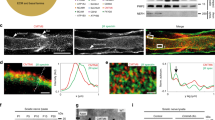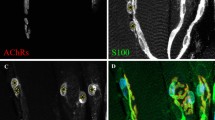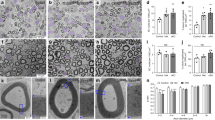Abstract
Here we studied the role of signaling through ErbB-family receptors in interactions between unmyelinated axons and non-myelinating Schwann cells in adult nerves. We generated transgenic mice that postnatally express a dominant-negative ErbB receptor in non-myelinating but not in myelinating Schwann cells. These mutant mice present a progressive peripheral neuropathy characterized by extensive Schwann cell proliferation and death, loss of unmyelinated axons and marked heat and cold pain insensitivity. At later stages, C-fiber sensory neurons die by apoptosis, a process that may result from reduced GDNF (glial cell line–derived neurotrophic factor) expression in the sciatic nerve. Neuregulin 1 (NRG1)-ErbB signaling mediates, therefore, reciprocal interactions between non-myelinating Schwann cells and unmyelinated sensory neuron axons that are critical for Schwann cell and C-fiber sensory neuron survival. This study provides new insights into ErbB signaling in adult Schwann cells, the contribution of non-myelinating Schwann cells in maintaining trophic support of sensory neurons, and the possible role of disrupted ErbB signaling in peripheral sensory neuropathies.
This is a preview of subscription content, access via your institution
Access options
Subscribe to this journal
Receive 12 print issues and online access
$209.00 per year
only $17.42 per issue
Buy this article
- Purchase on Springer Link
- Instant access to full article PDF
Prices may be subject to local taxes which are calculated during checkout







Similar content being viewed by others

References
Garratt, A.N., Britsch, S. & Birchmeier, C. Neuregulin, a factor with many functions in the life of a schwann cell. Bioessays 22, 987–996 (2000).
Falls, D.L., Rosen, K.M., Corfas, G., Lane, W.S. & Fischbach, G.D. ARIA, a protein that stimulates acetylcholine receptor synthesis, is a member of the neu ligand family. Cell 72, 801–815 (1993).
Holmes, W.E. et al. Identification of heregulin, a specific activator of p185erbB2. Science 256, 1205–1210 (1992).
Peles, E. et al. Isolation of the neu/HER-2 stimulatory ligand: a 44 kDa glycoprotein that induces differentiation of mammary tumor cells. Cell 69, 205–216 (1992).
Marchionni, M.A. et al. Glial growth factors are alternatively spliced erbB2 ligands expressed in the nervous system. Nature 362, 312–318 (1993).
Chen, M.S. et al. Expression of multiple neuregulin transcripts in postnatal rat brains. J. Comp. Neurol. 349, 389–400 (1994).
Corfas, G., Rosen, K.M., Aratake, H., Krauss, R. & Fischbach, G.D. Differential expression of ARIA isoforms in the rat brain. Neuron 14, 103–115 (1995).
Cohen, J.A., Yachnis, A.T., Arai, M., Davis, J.G. & Scherer, S.S. Expression of the neu proto-oncogene by Schwann cells during peripheral nerve development and Wallerian degeneration. J. Neurosci. Res. 31, 622–634 (1992).
Meyer, D. & Birchmeier, C. Multiple essential functions of neuregulin in development. Nature 378, 386–390 (1995).
Syroid, D.E. et al. Cell death in the Schwann cell lineage and its regulation by neuregulin. Proc. Natl. Acad. Sci. USA 93, 9229–9234 (1996).
Shah, N.M., Marchionni, M.A., Isaacs, I., Stroobant, P. & Anderson, D.J. Glial growth factor restricts mammalian neural crest stem cells to a glial fate. Cell 77, 349–360 (1994).
Mahanthappa, N.K., Anton, E.S. & Matthew, W.D. Glial growth factor 2, a soluble neuregulin, directly increases Schwann cell motility and indirectly promotes neurite outgrowth. J. Neurosci. 16, 4673–4683 (1996).
Garratt, A.N., Voiculescu, O., Topilko, P., Charnay, P. & Birchmeier, C. A dual role of erbB2 in myelination and in expansion of the schwann cell precursor pool. J. Cell Biol. 148, 1035–1046 (2000).
Jessen, K.R., Morgan, L., Stewart, H.J. & Mirsky, R. Three markers of adult non-myelin-forming Schwann cells, 217c(Ran-1), A5E3 and GFAP: development and regulation by neuron-Schwann cell interactions. Development 109, 91–103 (1990).
Brenner, M., Kisseberth, W.C., Su, Y., Besnard, F. & Messing, A. GFAP promoter directs astrocyte-specific expression in transgenic mice. J. Neurosci. 14, 1030–1037 (1994).
Zhuo, L. et al. Live astrocytes visualized by green fluorescent protein in transgenic mice. Dev. Biol. 187, 36–42 (1997).
Rio, C., Dikkes, P., Liberman, M.C. & Corfas, G. Glial fibrillary acidic protein expression and promoter activity in the inner ear of developing and adult mice. J. Comp. Neurol. 442, 156–162 (2002).
Rio, C., Rieff, H.I., Qi, P., Khurana, T.S. & Corfas, G. Neuregulin and erbB receptors play a critical role in neuronal migration. Neuron 19, 39–50 (1997).
Prevot, V. et al. Normal female sexual development requires neuregulin-erbB receptor signaling in hypothalamic astrocytes. J. Neurosci. 23, 230–239 (2003).
Patten, B.A., Peyrin, J.M., Weinmaster, G. & Corfas, G. Sequential signaling through Notch1 and erbB receptors mediates radial glia differentiation. J. Neurosci. 23, 6132–6140 (2003).
Julius, D. & Basbaum, A.I. Molecular mechanisms of nociception. Nature 413, 203–210 (2001).
Caterina, M.J. et al. Impaired nociception and pain sensation in mice lacking the capsaicin receptor. Science 288, 306–313 (2000).
Lee, D.E., Kim, S.J. & Zhuo, M. Comparison of behavioral responses to noxious cold and heat in mice. Brain Res. 845, 117–121 (1999).
Ji, R.R., Befort, K., Brenner, G.J. & Woolf, C.J. ERK MAP kinase activation in superficial spinal cord neurons induces prodynorphin and NK-1 upregulation and contributes to persistent inflammatory pain hypersensitivity. J. Neurosci. 22, 478–485 (2002).
Ji, R.R. & Rupp, F. Phosphorylation of transcription factor CREB in rat spinal cord after formalin-induced hyperalgesia: relationship to c-fos induction. J. Neurosci. 17, 1776–1785 (1997).
Hunt, S.P., Pini, A. & Evan, G. Induction of c-fos-like protein in spinal cord neurons following sensory stimulation. Nature 328, 632–634 (1987).
Bennett, D.L. et al. A distinct subgroup of small DRG cells express GDNF receptor components and GDNF is protective for these neurons after nerve injury. J. Neurosci. 18, 3059–3072 (1998).
Averill, S., McMahon, S.B., Clary, D.O., Reichardt, L.F. & Priestley, J.V. Immunocytochemical localization of trkA receptors in chemically identified subgroups of adult rat sensory neurons. Eur. J. Neurosci. 7, 1484–1494 (1995).
Snider, W.D. & McMahon, S.B. Tackling pain at the source: new ideas about nociceptors. Neuron 20, 629–632 (1998).
Buj-Bello, A., Buchman, V.L., Horton, A., Rosenthal, A. & Davies, A.M. GDNF is an age-specific survival factor for sensory and autonomic neurons. Neuron 15, 821–828 (1995).
Matheson, C.R. et al. Glial cell line-derived neurotrophic factor (GDNF) is a neurotrophic factor for sensory neurons: comparison with the effects of the neurotrophins. J. Neurobiol. 32, 22–32 (1997).
Zwick, M. et al. Glial cell line-derived neurotrophic factor is a survival factor for isolectin B4-positive, but not vanilloid receptor 1-positive, neurons in the mouse. J. Neurosci. 22, 4057–4065 (2002).
Hammarberg, H. et al. GDNF mRNA in Schwann cells and DRG satellite cells after chronic sciatic nerve injury. Neuroreport 7, 857–860 (1996).
Naveilhan, P., ElShamy, W.M. & Ernfors, P. Differential regulation of mRNAs for GDNF and its receptors Ret and GDNFR alpha after sciatic nerve lesion in the mouse. Eur. J. Neurosci. 9, 1450–1460 (1997).
Trupp, M., Belluardo, N., Funakoshi, H. & Ibanez, C.F. Complementary and overlapping expression of glial cell line-derived neurotrophic factor (GDNF), c-ret proto-oncogene, and GDNF receptor-alpha indicates multiple mechanisms of trophic actions in the adult rat CNS. J. Neurosci. 17, 3554–3567 (1997).
Brown, M.J., Martin, J.R. & Asbury, A.K. Painful diabetic neuropathy. A morphometric study. Arch. Neurol. 33, 164–171 (1976).
Dutsch, M. et al. Small fiber dysfunction predominates in Fabry neuropathy. J. Clin. Neurophysiol. 19, 575–586 (2002).
Barbieri, S. et al. Small fibre involvement in neuropathy associated with IgG, IgA and IgM monoclonal gammopathy. Electromyogr. Clin. Neurophysiol. 35, 39–44 (1995).
Crone, S.A., Negro, A., Trumpp, A., Giovannini, M. & Lee, K.F. Colonic epithelial expression of ErbB2 is required for postnatal maintenance of the enteric nervous system. Neuron 37, 29–40 (2003).
Scherer, S.S. & Salzer, J.L. Axon-Schwann cell interactions in peripheral nerve regeneration. in Glial Cell Development (eds. Jessen, K.R. & Richardson, W.D.) 165–198 (Oxford: Bios Scientific Publishers, 1996).
Lewis, S.E. et al. A role for HSP27 in sensory neuron survival. J. Neurosci. 19, 8945–8953 (1999).
Tandrup, T., Woolf, C.J. & Coggeshall, R.E. Delayed loss of small dorsal root ganglion cells after transection of the rat sciatic nerve. J. Comp. Neurol. 422, 172–180 (2000).
Benn, S.C. et al. Hsp27 upregulation and phosphorylation is required for injured sensory and motor neuron survival. Neuron 36, 45–56 (2002).
Johnson, E.M. Jr., Taniuchi, M. & DiStefano, P.S. Expression and possible function of nerve growth factor receptors on Schwann cells. Trends Neurosci. 11, 299–304 (1988).
Widenfalk, J., Lundstromer, K., Jubran, M., Brene, S. & Olson, L. Neurotrophic factors and receptors in the immature and adult spinal cord after mechanical injury or kainic acid. J. Neurosci. 21, 3457–3475 (2001).
Sanchez, R.M. et al. Decreased glutamate receptor 2 expression and enhanced epileptogenesis in immature rat hippocampus after perinatal hypoxia-induced seizures. J. Neurosci. 21, 8154–8163 (2001).
Ji, R.R., Baba, H., Brenner, G.J. & Woolf, C.J. Nociceptive-specific activation of ERK in spinal neurons contributes to pain hypersensitivity. Nat. Neurosci. 2, 1114–1119 (1999).
Pover, C.M., Orr, M.H., Jr. & Coggeshall, R.E. A method for producing unbiased histograms of neuronal profile sizes. J. Neurosci. Methods 49, 123–131 (1993).
Coggeshall, R.E. & Lekan, H.A. Methods for determining numbers of cells and synapses: a case for more uniform standards of review. J. Comp. Neurol. 364, 6–15 (1996).
Acknowledgements
Supported by National Institutes of Health grants: NINDS R01 NS35884 (G.C.), NIDCD R01 DC04820 (G.C.), NS40698 (R.R.J.), NS38253 (C.J.W.) and NS39518 (C.J.W.). Also supported by the EJLB Foundation (G.C.) and a Mental Retardation Research Center grant NIH P30-HD 18655 (G.C.). We thank N. Akhtar for technical assistance, B. Patten for comments, K. Stankovic for help with some experiments and S. Ito and the Harvard Medical School EM facility for their assistance with EM.
Author information
Authors and Affiliations
Corresponding author
Ethics declarations
Competing interests
The authors declare no competing financial interests.
Rights and permissions
About this article
Cite this article
Chen, S., Rio, C., Ji, RR. et al. Disruption of ErbB receptor signaling in adult non-myelinating Schwann cells causes progressive sensory loss. Nat Neurosci 6, 1186–1193 (2003). https://doi.org/10.1038/nn1139
Received:
Accepted:
Published:
Issue Date:
DOI: https://doi.org/10.1038/nn1139
This article is cited by
-
Mechanisms of Schwann cell plasticity involved in peripheral nerve repair after injury
Cellular and Molecular Life Sciences (2020)
-
Pathologic remodeling in human neuromas: insights from clinical specimens
Acta Neurochirurgica (2019)
-
EGFR-Stat3 signalling in nerve glial cells modifies neurofibroma initiation
Oncogene (2017)
-
Axons hooked to Schwann cell metabolism
Nature Neuroscience (2014)
-
Differential expression of neuregulin-1 isoforms and downregulation of erbin are associated with Erb B2 receptor activation in diabetic peripheral neuropathy
Acta Neuropathologica Communications (2013)


